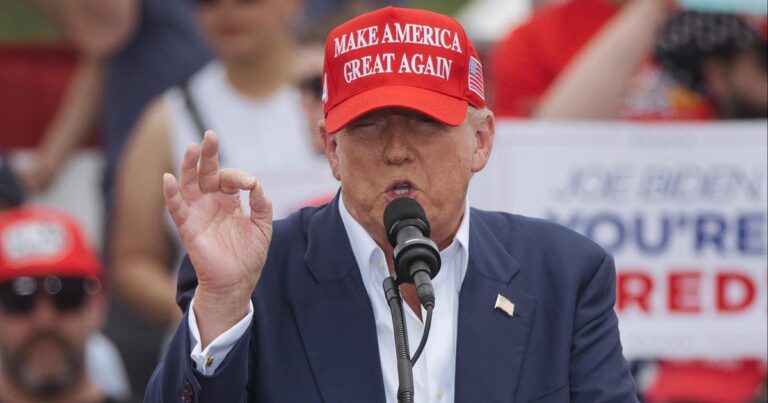Project 2025, a 900-page blueprint for the next Republican president, has attracted attention for its proposed reforms to the federal government, including a major overhaul of the U.S. tax code.
President Biden and Democrats have referred to Project 2025 in recent weeks to try to highlight what would happen if former President Donald Trump wins the November election and retakes the White House in January. Many of the blueprint’s proposals touch on economic issues that could affect millions of Americans, as well as social issues such as abortion and diversity, equity and inclusion (DEI).
Project 2025, overseen by the conservative Heritage Foundation, is being spearheaded by two former Trump administration officials: project director Paul Dans, who served as chief of staff at the Office of Personnel Management, and Spencer Chretien, a former special assistant to Trump who is now deputy director of the project.
If enacted, Project 2025’s tax proposals could affect all U.S. adults by eliminating the country’s longstanding system of multiple tax brackets designed to ensure that low-income Americans pay a smaller share of their income in federal taxes than middle- and higher-income workers.
Currently, there are seven tax brackets — 10%, 12%, 22%, 24%, 32%, 35%, and 37% — based on income thresholds. For example, a married couple pays 10% in federal income tax on the first $23,200 of income, and 12% on income between $23,201 and $94,300. A married couple would need to earn more than $487,450 this year to reach the top tax bracket of 37%.
Project 2025 argues that the current tax system is too complicated and expensive for taxpayers. To solve these problems, the document says, the project proposes just two tax rates: a 15% flat tax on people earning up to about $168,000 a year, and a 30% income tax on those earning more. It also proposes eliminating most deductions, credits, and exemptions, but doesn’t specify which deductions and exemptions would remain.
“The federal income tax system is progressive, meaning that people with higher incomes pay higher marginal tax rates than people with lower incomes,” Brendan Duke, senior director of economic policy at the left-leaning Center for American Progress, told CBS MoneyWatch. “Conservatives look at this and feel it’s unfair to tax the wealthy as a higher percentage of their income than lower-income households.”
Project 2025’s proposal “is a dramatic overhaul of how government is funded, asking the wealthy to give more than lower-income families,” he said. “It shifts taxes from the wealthy to the middle class, and that’s it.”
The Heritage Foundation and Project 2025 did not immediately respond to requests for comment.
Project 2025 Tax Rates
Millions of low- and middle-class families would likely face huge tax increases, under Project 2025’s proposals.
Duke estimated that a middle-class family with two children making $100,000 a year would pay an extra $2,600 in federal income taxes if the 10% and 12% tax brackets were eliminated and income was taxed at a flat 15% rate. If the child tax credit were also eliminated, Duke said, that would amount to an extra $6,600 compared to the current tax system.
By comparison, he estimated that a couple with two children making $5 million a year would get a tax cut of $325,000.
“The 15 percent tax bracket is a huge deal in terms of raising taxes on middle-class families,” Duke said.
Millions of American households earning less than $168,000 would likely face a tax increase of 15 percent. Currently, the bottom half of American taxpayers earning less than $46,000 a year would Effective tax rate: 3.3% This reflects income tax after deductions, tax credits, and other benefits.
Other tax and economic reforms proposed in Project 2025 include:
- The reduction in the corporate tax rate from the current 21% to 18% was enacted in the Tax Cuts and Jobs Act of 2017. Pre-TCJA, the corporate tax rate was 35%.
- Reduce capital gains tax to 15%. Currently, high-income earners pay 20% tax on capital gains.
- Eliminates credits for green energy projects created by the Inflation Reduction Act.
- We are considering introducing a US consumption tax similar to a national tax.
- Eliminate the Federal Reserve’s obligation to maintain full employment in the labor market.
To be sure, tax reform requires lawmakers to approve changes to the tax code, which can be difficult when the House or Senate are controlled by the opposing party. For example, President Trump got his Tax Cuts and Jobs bill passed by a Republican-led Congress, but no Democrats voted for the bill.
What does President Trump have to say about Project 2025?
Trump has distanced himself from Project 2025 and has proposed his own plan on the campaign trail through “Agenda 47.” Trump has not yet offered any concrete tax proposals, but 10% tariff on all imports And a 60% tariff on Chinese imports could raise enough money to eliminate the federal income tax.
But tax experts say the math doesn’t add up because the revenue from the new tariffs would be far short of making up for the more than $2 trillion in personal income taxes the IRS collects each year, and consumers would likely pay higher costs for imported consumer goods and services that are subject to tariffs, they say.
“Tariffs are consumption taxes, [Project 2025’s] “The tax reform and what President Trump has talked about is abolishing taxes instead of a sales tax,” Duke said.


